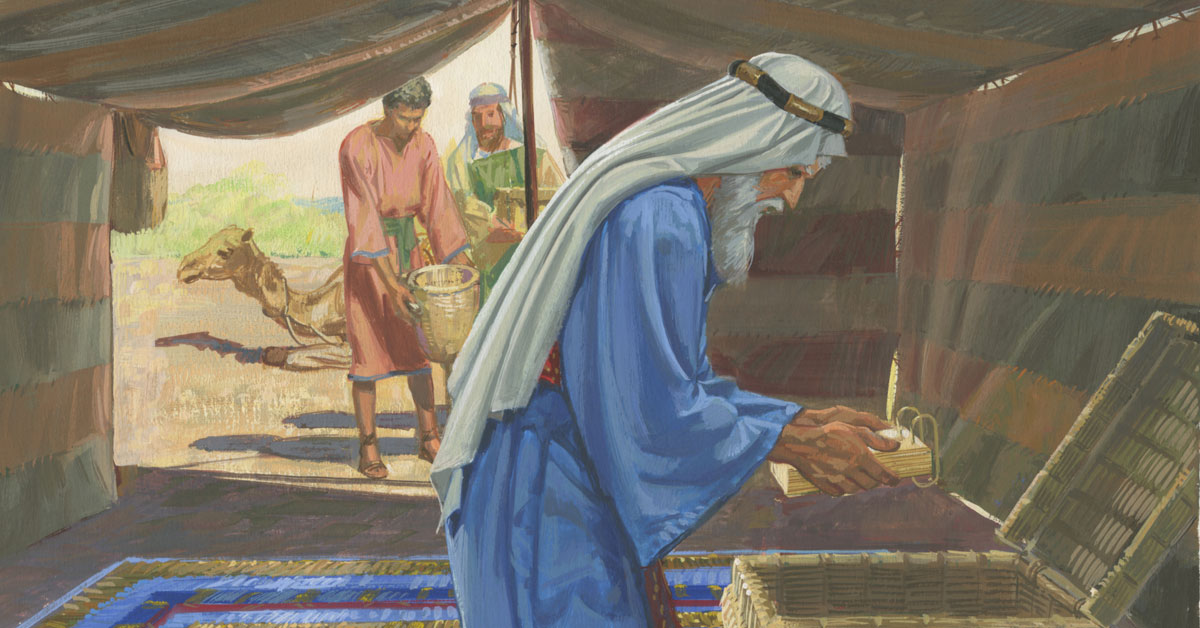You are here
Why New Testament Words and Phrases Are in the Book of Mormon Part 5: How Often Were Scriptures on the Plates of Brass the Common Source?

Jacob 1:7; cf. Hebrews 3:8; Psalm 95:8
This is the fifth in a series of KnoWhys looking at the question of “Why New Testament Words and Phrases Are in the Book of Mormon”
The Know
In the previous parts of this series, we discussed the idea that much of the New Testament-type material in the Book of Mormon may have been introduced by the resurrected Savior himself (Part 2) or through direct revelation to the Nephite prophets (Parts 3 and 4). Besides these, another source for phrases that seem to match parts of the New Testament is the plates of brass that Lehi’s family had in their possession. Far more often than readers usually realize, many New Testament passages are quoting or paraphrasing Old Testament texts that could have been available to the Nephites through the plates of brass. For example:
- When Abinadi declared that “the grave should have no victory and that death should have no sting” (Mosiah 16:7–8), his words are very similar to what Paul says in 1 Corinthians 15:54–56 (“O death, where is thy sting? O grave, where is thy victory?”). But it is likely that both Paul and Abinadi were borrowing from Old Testament passages such as Isaiah 25:8 (“He will swallow up death in victory”) and Hosea 13:14 (“I shall ransom them from the power of [the Grave]; I shall redeem them from Death. O Death, where are your plagues? O [Grave], where is your sting?”).1
- Although the line used by Nephi’s brother, Jacob, “as in the provocation in the day of temptation … in the wilderness” (Jacob 1:7) matches Hebrews 3:8 (“as in the provocation, in the day of temptation in the wilderness”), it is clear that the source of both passages is Psalm 95:8 (“as in the provocation, and as in the day of temptation in the wilderness”).2
Where post-exilic3 Old Testament texts (presumably unavailable to the Nephites) are the source of a phrase in the New Testament, it is often possible that those expressions could have been using pre-exilic phrases that existed in early Hebrew language and literature but did not survive in pre-exilic biblical records.
- Readers may readily compare Lehi’s words in 1 Nephi 8:12 (“as I partook of the fruit thereof it filled my soul with exceedingly great joy”) to Matthew 2:10: “When they saw the star, they rejoiced with exceeding great joy.” A possible Old Testament source for this expression is Nehemiah 12:43, where, when the walls of Jerusalem had been rebuilt, God made the people to “rejoice with great joy.” However, this is a post-exilic text that would not have been found on the plates of brass. But this expression was apparently used for many such occasions in pre-exilic times as well, especially involving the building, dedication, and use of Solomon’s Temple, as can be seen in 1 Chronicles 29:9, Psalm 43:4, and Psalm 68:3.
- The allegory of the olive tree in the book of Jacob contains many parallels to a similar allegory in Romans 11. However, both possess similarities with passages in Ezekiel, where the prophet speaks of problems with the top of a tree, taking young, tender branches and planting them elsewhere (Ezekiel 17). Ezekiel’s writings were recorded after Lehi had left Jerusalem. However, there are also parallels to Ezekiel’s allegory in pre-exilic writings such as Hosea 14, Isaiah 5, and Jeremiah 11. Latter-day saint scholars have argued that Zenos’s allegory in Jacob 5 may predate and serve as inspiration for all of these.4
The Why
Readers of the Bible are likely aware that the New Testament authors often quote or make reference to Old Testament passages. Conservative estimates list at least 295 direct citations of Old Testament passages, occupying some 352 verses of the New Testament, or more than four percent. This indicates that nearly one in 23 verses of the New Testament is a quotation of the Old Testament.5
Although they often directly cite Old Testament passages, there are also many instances where New Testament authors can be seen to clearly allude to or paraphrase Scripture. Because these examples can be more difficult to detect, estimates of the total number of references to the Old Testament in the New vary greatly, ranging from around 600 by some counts to over 4000. It would not be an exaggeration to assert that over ten percent of the New Testament text is drawn from the Old Testament and it could be more than that.6
One of the reasons that many of the Old Testament references are so hard to identify is that there is not always a citation formula such as “it is written” or “thus saith the prophet” to indicate that a scripture is being used.7 Furthermore, when New Testament authors echoed, alluded to, or paraphrased Old Testament passages, they often used the scriptural language freely and without attribution. As noted by biblical scholar Steve Moyise, “Allusions are less precise [than quotations], picking up on a few key words and usually woven into the new composition.”8
Additionally, in many instances where the New Testament is quoting the Old, the quotation is difficult to recognize because the translators of the King James Version of the Bible did not attempt to be consistent in how they translated equivalent words and phrases from the Hebrew of the Old Testament and the Greek of the New Testament into English.9 For example, for this reason even the names of famous prophets are spelled differently in the New Testament: Isaiah = Esaias, Noah = Noe, Elijah = Elias, and Joshua = Jesus. Due to these types of issues, Isaiah’s prophecy in Isaiah 40:3, “Prepare the way of the Lord; make straight in the desert a highway for our God,” became, in Matthew 3:3, “Prepare the way of the Lord; make His paths straight,” and in John 1:27, “Make straight the way of the Lord.”10
With this in mind, readers may be unaware that sometimes what appears to be a New Testament phrase or passage in the Book of Mormon may originally be from the Old Testament. What initially seems to be an anachronistic use of later Christian scripture may actually be a quotation or paraphrase from something to which the Nephites had access on the plates of brass.
Although this is not the case for all New Testament material in the Book of Mormon, this perspective can be a helpful one for those who encounter New Testament language in their Book of Mormon reading and want to know why it is there. Readers can analyze the relevant New Testament passages (and perhaps consult biblical commentaries and other scholarly resources) to see if the New Testament author may have been utilizing a more ancient Old Testament text in his writing.11
The appearance of Old Testament writings and prophecies in both the New Testament and the Book of Mormon can serve as a testimony to readers that the authors of these latter two books of Scripture considered the writings of the Old Testament to undoubtably be the word of God and felt that it was their duty and privilege to share these sacred texts for the eternal benefit of others.
This KnoWhy was made possible by the generous contributions of Bryson & Jan Garbett.
Further Reading
Book of Mormon Central, “What are the Roots of Zenos’s Allegory in the Ancient World? (Jacob 5:3),” KnoWhy 70 (April 4, 2016).
Book of Mormon Central, “Is Anything Known of the Prophet Zenos Outside of the Book of Mormon? (Jacob 5:1),” KnoWhy 67 (March 31, 2016).
Gary J. Coleman, “The Book of Mormon: A Guide for the Old Testament,” Ensign (Jan 2002): 45–55.
John Hilton III, “Old Testament Psalms in the Book of Mormon,” in Ascending the Mountain of the Lord: Temple, Praise, and Worship in the Old Testament (2013 Sperry Symposium), ed. Jeffrey R. Chadwick, Matthew J. Grey, and David Rolph Seely (Provo, UT: Religious Studies Center, Brigham Young University; Salt Lake City: Deseret Book, 2013), 291–311.
David Rolph Seely and John W. Welch, “Zenos and the Texts of the Old Testament,” in The Allegory of the Olive Tree: The Olive, the Bible, and Jacob 5, ed. Stephen D. Ricks and John W. Welch (Salt Lake City and Provo, UT: Deseret Book and FARMS, 1994), 322–346.
- 1. Hosea 13:14, English Standard Version. The ESV uses “Sheol” (“Hell”), following the Hebrew, but this is translated as “the grave” in the KJV.
- 2. On Jacob’s use of Psalm 95 and other psalms, see Book of Mormon Central, “Why Does Jacob Quote So Much from the Psalms? (Jacob 1:7),” KnoWhy 62 (March 25, 2016); John Hilton III, “Old Testament Psalms in the Book of Mormon,” in Ascending the Mountain of the Lord: Temple, Praise, and Worship in the Old Testament (2013 Sperry Symposium), ed. Jeffrey R. Chadwick, Matthew J. Grey, and David Rolph Seely (Provo, UT: Religious Studies Center, Brigham Young University; Salt Lake City: Deseret Book, 2013), 291–311.
- 3. The term “post-exilic” refers to the period of time in the Bible that starts in 538 B.C., following the 70 years the Jews spent as captives in Babylon (“the Babylonian exile” or “Babylonian captivity”). The pre-exilic period ended in about 600 B.C., when King Nebuchadnezzar of Babylon destroyed Jerusalem and took many of its inhabitants captive. This was just after Lehi and his family left Jerusalem to go to the promised land.
- 4. For more on this topic, see Book of Mormon Central, “What are the Roots of Zenos’s Allegory in the Ancient World? (Jacob 5:3),” KnoWhy 70 (April 4, 2016); Book of Mormon Central, “Is Anything Known of the Prophet Zenos Outside of the Book of Mormon? (Jacob 5:1),” KnoWhy 67 (March 31, 2016); David Rolph Seely and John W. Welch, “Zenos and the Texts of the Old Testament,” in The Allegory of the Olive Tree: The Olive, the Bible, and Jacob 5, ed. Stephen D. Ricks and John W. Welch (Salt Lake City and Provo, UT: Deseret Book and FARMS, 1994), 322–346.
- 5. Roger Nicole, “New Testament Use of the Old Testament,” online essay reproduced from Revelation and the Bible, ed. Carl. F.H. Henry (Grand Rapids, MI: Baker, 1958), pp. 137-151, accessed online at http://www.bible-researcher.com/nicole.html.
- 6. Nicole, “New Testament Use of the Old Testament.”
- 7. Although, according to Nicole, there are about 224 direct citations that do include this type of introductory statement. See Nicole, “New Testament Use of the Old Testament.”
- 8. Steve Moyise, The Old Testament in the New: An Introduction (2nd Ed. London: Bloomsbury T&T Clark, 2015), 7. Additionally, the New Testament authors were often quoting from biblical texts and translations, like the Greek Septuagint, that did not always match precisely the versions that were eventually translated into English as the King James Version that we use today. This fact, among other reasons, resulted in variations between the rendering of Old and New Testament texts that can create the illusion that a quoted passage in the New is not related to the source text in the Old. A simple illustration of this would be Hebrews 9:20, which quotes the words of Moses in Exodus 24:8. Hebrews 9:20 (in the KJV) renders the statement as “This is the blood of the testament which God hath enjoined unto you.” Compare this to how the original quote reads in the Old Testament: “Behold the blood of the covenant, which the LORD hath made with you.” There are many examples of apparent discrepancies like these in the New Testament’s use of the Old that would make it difficult for readers to immediately notice that an Old Testament passage is being used without reading the contexts of both passages.
- 9. There were actually separate committees assigned to translate the Old Testament and the New Testament. Furthermore, Old Testament passages used in the New Testament were often drawn from the Septuagint (LXX), the ancient Greek translation of the Hebrew Old Testament, which often contained notable or significant differences from the Hebrew version of the text. Thanks go to Robert Smith for emphasizing this point in a personal email to Book of Mormon Central.
- 10. Perhaps for the benefit of English-speaking readers of the Book of Mormon who would possibly be more familiar with the New Testament version of a quoted Old Testament passage, the Book of Mormon sometimes presents Old Testament passages in the form that they appear in the New Testament. For example, Jacob 4:17 alludes to Psalm 118:22, but the wording it uses is closer to the quotation of that psalm found in Matthew 21:42; Mark 12:10.
- 11. See, for example, helpful texts such as G.K. Beale and D.A. Carson, eds., Commentary on the New Testament Use of the Old Testament (Grand Rapids, MI: Baker Academic, 2007), or online resources like this list of “Parallel Passages in New Testament Quoted from Old Testament” on blueletterbible.org. Also, New Testament writers occasionally utilized other ancient religious texts that are not found in the Old Testament. For example, Jude 1:14–15 quotes from an ancient Jewish text known as 1 Enoch (1 Enoch 1:9). Quotes from outside texts such as this can, naturally, be even more difficult to identify.
KnoWhy Citation
Related KnoWhys
Subscribe
Get the latest updates on Book of Mormon topics and research for free





